The Communist International, the Bourgeois Armed Forces and the Work Therein for the Uprising
Existing translations
- DIE KOMMUNISTISCHE INTERNATIONALE, DIE BÜRGERLICHEN STREITKRÄFTE UND DIE ARBEIT IN IHNEN FÜR DEN AUFSTAND
- The Communist International, the Bourgeois Armed Forces and the Work Therein for the Uprising
- LA INTERNACIONAL COMUNISTA, LAS FUERZAS ARMADAS BURGUESES Y EL TRABAJO EN ELLOS PARA LA INSURRECCION.
- L'INTERNATIONALE COMMUNISTE, LES FORCES ARMÉES BOURGEOISES ET LE TRAVAIL EN LEUR SEIN POUR L'INSURRECTION
- Коммунистический Интернационал, буржуазные военные силы и работа в них с целью восстания
The Russian tsarist army had to master its participation in the 1st World War under quite difficult conditions with regard to combat technique and the conscription of millions of peasants who were not at all or little prepared for the war. Millions died, were injured or captured. And the propaganda for the revolution that was spread at the war front contributed to their being demoralized. Some of them did not oppose the insurgents in February 1917 or even gave them support. The same happened in October.
Based on this revolutionary experience, the Communist International (CI) gave a clear directive that the preparation of the uprising required that revolutionary parties do work within the reactionary army with the aim of dividing and undermining it and drawing parts of the army to the side of the revolution. And build up an apparatus paralleling that of the party. In Latin America this directive was not completely followed. For example, after the wars of independence in the 19th century the Europeans initially built up modern armies. However, it was US imperialism which directly trained high-ranking and middle-ranking officers in the armies of the Latin American states and transformed them into professional armies with an ideological concept directed against people's struggles. In the 30 years between 1950 and 1980 alone, 64,000 officers and soldiers were trained at US military bases in the USA and Panama.
The experience of the Cuban Revolution was that of the rebel army of Fidel and “Che”, which fought against the reactionary army of Fulgencio Batista until it was dissolved after the victory of the revolution in 1959.
Something similar happened in the Nicaraguan revolution. The forces of the Sandinista National Liberation Front (FSLN) fought against Anastasio Somoza's troops till the very end in the Managua Uprising in 1979.
In the case of Colombia, guerrilla groups fought for 60 years against the official army. The FARC guerrillas almost gained victory in 1998, but following the government offensive they came into the defensive, and at the end of 2016 had to sign a peace treaty with the government. In the case of the ELN (National Liberation Army) experience shows that it, too, did not try to organize work within the army of the reactionary forces.
It was more or less the same in El Salvador and Guatemala. There are examples such as those of Jacobo Arbenz from Guatemala, who was named the "militar del pueblo" (soldier of the people). With parts of the army he promoted an armed uprising in 1944 which was supported by the CP Guatemala. But they did not succeed in taking over power. Arbenz was elected as the country's president in 1951.
The most symbolic example of the directive of the CI for organizing work within the army for the uprising was the failure of the uprising of the communists in Brazil in 1935. With parts of the official army, the communists began an uprising in the belief that this would be possible. They assumed that it could be performed according to the “scheme of the uprising of the October Revolution” by taking over key positions of power. And since in the opinion of the delegates of the CI and the PCB (Communist Party of Brazil) Brazil was a semi-feudal country, they thought that the peasants would immediately support the revolution and take over power in the entire country. The leadership of the uprising did not understand that Brazil already had a modern army structure in the entire country with an esprit de corps, and that this was not the way. They were defeated within two days.
The putsch in Chile during the Allende government in 1973 showed that the army was on the side of fascism. In the case of Venezuela, parts of the army were on Chavez's side before he became president of the republic, and when he was president the army supported him. It is possible that conflicts arise today. And if it comes to more violence on the part of the opposition, we will see on whose side the army is. In any case, the militias are being trained by the army. The case of Venezuela deserves to be observed.
Consequently, the lesson of the Socialist October Revolution of 1917 was that to build up the political and armed forces for the revolution you cannot apply the politics and methods which served the “October path”, but not the Latin America path, because revolutions can “neither be an imitation nor a copy” of a single revolution (Mariategui), far less that of the Russian Revolution, which took place under “exceptional conditions”, as Lenin put it. The examples of the Mexican revolution, the Prestes’ Column in Brazil and the Cuban Revolution must be studied.
August 2017
Document Actions




